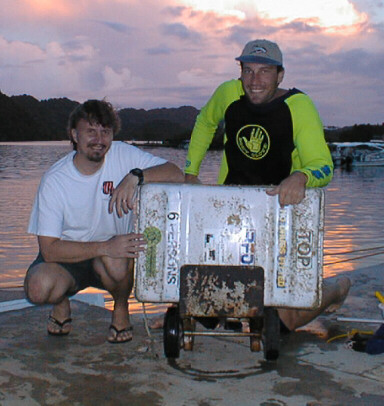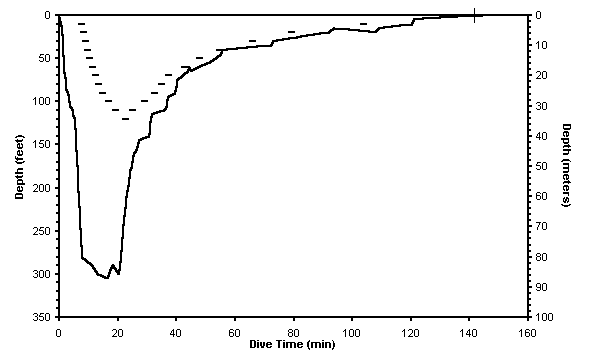Daily Log Report for
7
May 1997
Submitted by Richard Pyle
 Pat's a very interesting guy.
He's been diving since the days of wooden tanks and iron
men. He experimented with open-circuit
trimix in the
early 1970's to explore coral reefs at depths beyond
those accessible with conventional scuba. Inspired by
Walter Starck's "Electrolung" (the first
functional electronically-controlled closed-circuit
rebreather), he also at that time began building his own
rebreathers. In fact, Pat is sort-of the
"Godfather" of coral-reef Twilight Zone
exploration. He has published more papers discussing
organisms of this region than any other single author
(mostly from work with research submersibles in the
Caribbean and Marshall Islands). Now, Pat and his wife
Lori Bell Colin are explorers in a different but related
field. They run the Coral Reef
Research Foundation in Palau (and are our very
gracious hosts for this expedition), which primarily
focuses on collecting soft-bodied marine organisms for
extraction of medically important biomolecules (i.e.,
potential wonder-drugs from the sea), for the National
Cancer Institute.
Pat's a very interesting guy.
He's been diving since the days of wooden tanks and iron
men. He experimented with open-circuit
trimix in the
early 1970's to explore coral reefs at depths beyond
those accessible with conventional scuba. Inspired by
Walter Starck's "Electrolung" (the first
functional electronically-controlled closed-circuit
rebreather), he also at that time began building his own
rebreathers. In fact, Pat is sort-of the
"Godfather" of coral-reef Twilight Zone
exploration. He has published more papers discussing
organisms of this region than any other single author
(mostly from work with research submersibles in the
Caribbean and Marshall Islands). Now, Pat and his wife
Lori Bell Colin are explorers in a different but related
field. They run the Coral Reef
Research Foundation in Palau (and are our very
gracious hosts for this expedition), which primarily
focuses on collecting soft-bodied marine organisms for
extraction of medically important biomolecules (i.e.,
potential wonder-drugs from the sea), for the National
Cancer Institute.About three years ago, a boat sank not far from where we have been conducting our dives these past couple of days. This boat contained a lot of very valuable scientific and photographic equipment, including an Arriflex 16-mm movie camera sealed inside an underwater housing; a (then experimental) digital Betacam, also in an underwater housing; an ROV; and an assortment of othe expensive goodies. The day after the boat went down, Pat made a dive along the drop-off where the boat had tumbled down the reef. Below 200 feet, he saw what he thought was a set of double scuba tanks, but on closer inspection, turned out to be a life raft. Based on where the fuel from the boat was coming to the surface, Pat calculated that it was probably in excess of 1,000 deep.
Keeping all this in mind, while in pursuit of new species, we always kept our eyes open for "debris" that might have fallen out of the boat as it tumbled down the reef. In yesterday's dive log report, I neglected to mention that, at the end of my dive, when I began my ascent past 300 feet, I came across a large box, perched right on the edge of a drop to a black abyss, that looked for all the world like a case that a photographer would put a camera and underwater housing in. It was encrusted with an assortment of marine life, but I could make out several multi-colored stickers on the case (you know...the kind that photographers like to put on their camera cases...). I tried to pick the object up, but immediately came to two very obvious conclusions: the case had no handles on it, and it was much too heavy for me to bring up. Throughout the decompression, I desperately wanted to tell Ken (the camera-geek among us fish-nerds) about this find, but decided the drama would be enhanced after we were on the boat, where there would be no barriers to communication.
After we completed our decompression, and climbed into the boat, I waited for just the right moment to say "Oh, by the way, Ken, at the end of the dive, at 300 feet, I came across this big box that, for all the world, looked like a camera case." After Ken directed a few explicatives in my direction, and nearly threw me off the boat (believing that I was being less than truthful), a large grin came across his face.
You probably can guess what was at the forefront of
our minds during this morning's descent, following the
"bread crumbs" of my own debris which I had
intentionally left during yesterday's ascent, to ensure
that we would be able to find the treasure chest once
again. Pat and I were the first on the scene, and when
Pat saw the box, he made a rocking motion with his hands,
which I immediately interpreted as "don't move it or
it might fall off the drop-off into the abyss".
Needless to say, Ken went straight for the box to attempt
to assess its contents. Ken's brain was repeating over
and over, "Betacam -- it's gotta be the Betacam.
Maybe it's the Arriflex. Nope, I think think it's the
Betacam." Desperate for an answer, he started
rubbing off the marine life so he could read the
stickers. "S. PEARSONS" was what Ken read on
one of them, and his mind scrolled through the different
rental houses for expensive underwater camera equipment.
"No wait", he thought..."it says '6
PERSONS', not 'S. PEARSONS'...it must be a 6-person
Betacam! Wow, I've never heard of a 6-person
Betacam....this must be REALLY expensive
equipment!" But then the helium, and it's amazing
ability to allow clarity of thought on deep dives,
started to kick in. Reluctantly, Ken forced himself to
acknowledge that this box contained neither a Digital
Betacam, nor an Arriflex 16-mm camera, but instead was,
in fact, the same life raft that Pat had seen 3 years
earlier. After scooping some cool new fishes (see below),
we decided to lash a rope around the box and haul it to
the surface.
No, it wasn't an expensive camera in a housing; it was a near-worthless life-raft. To add insult to injury, it reeked of hydrogen sulfide, no-doubt a result of the anoxic water inside the case. It wasn't a total loss, however: there were all sorts of interesting critters attached to the case, some of which might eventually prove to be new species. Hauling this incredibly heavy, smelly, worthless object into the boat, I inadvertently tugged on the "painter" line (which, when pulled, inflates the raft ballistically, shedding it's plastic case). Had I tugged a wee bit harder, we would have spent this entire evening scrubbing our bodies in a futile attempt to rid ourselves of the smell of rotten eggs. Pat, of course, was thoroughly amused with our antics.
Me and Ken, at the end of the day, with our recovered booty..
